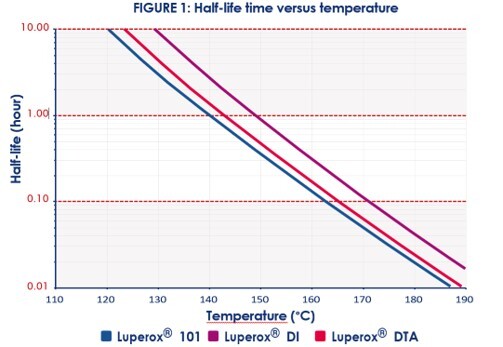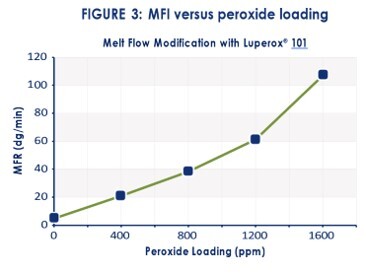POLYPROPYLENE
Peroxide Selection Guidelines
The goal is to improve the melt flow properties of poly-propylene (PP) after the polymerization process. The peroxide can be added in the hopper or in the extruder as a liquid (pure or diluted with solvent) or as a solid masterbatch (peroxide is absorbed or coated on PP carrier).
Luperox® 101, Luperox® DTA or Luperox® DI can be used, see Figure 1 and 2.

FIGURE 2: Characteristics of organic peroxides CR-PP
|
Organic Peroxide |
Advantage |
|---|---|
|
Luperox® 101 |
Available in liquid and solid formulations |
|
Luperox® DTA |
No tert-butanol by product |
|
Luperox® DI |
Cost efficiency |
The main advantages of organic peroxides in polypropylene modification are:
•The excellent control of the melt flow index (MFI) increase, see Figure 3.
•The narrowing of the molecular weight distribution (MWD) and the flexibility in its control.
•A high efficiency of the selected organic peroxide at operational temperature.
•A low cost process to achieve required MFI.
•A variety of grades can be produced from one single PP resin.
•A PP resin with increased clarity and better heat distortion.
Main criteria to select the most efficient peroxide
Technology of injection (physical form of peroxide grade)
•Extruder temperature (200-250°C): above 240°C, thermal degradation becomes significant
•Extruder residence time: 8-10 x half-life time of the peroxide at a given process temperature is required to get a complete decomposition without residual
•Final MFI and MWD polypropylene properties
•Acceptable residual peroxide level.

A broad range of organic peroxide formulations
The main advantage of a diluted peroxide grade is to provide a better accuracy in dosage and a better homogeneity, especially when the required quantity of peroxide is low. To make the handling and the dosage for operators easier, these different formulations of organic peroxides can be supplied in larger containers like big bags for solids (up to 500 kgs) or like IBC (1 ton) for liquids.
| Formulation |
Assay |
Physical form |
|---|---|---|
|
Luperox® 101MO32 |
32% |
Liquid |
|
Luperox® 101MO50 |
50% |
Liquid |
|
Luperox® 101MO70 |
70% |
Liquid |
|
Luperox® 101PP7,5G |
7,5% |
Granules (2-3mm) |
|
Luperox® 101PP10G |
10% |
Granules (2-3mm) |
|
Luperox® 101PP20G |
20% |
Granules (2-3mm) |
When the addition of solid peroxide is required, Arkema is proposing masterbatches in granules on a PP carrier. Various solid or liquid (in mineral oil) peroxide predispersions, based on Luperox® 101, with different concentration levels are described in Figure 4.
Solid dispersions of peroxides offer some advantages related to:
•Productivity: excellent dosing accuracy and dispersion in the extruder;
•Quality: no lumping and acceptable odor levels;
•Handling: free flowing powders;
•Safety: lower risk associated to flash point.
High melt strength polypropylene (HMS – PP)
Melt strength of polypropylene in molten state may be too low especially for applications requiring stretching. For that reason, it may become very interesting to use an organic peroxide able to limit the visbreaking and favor the grafting of specific chains and/or agents to enhance the melt strength and improve the stretching behavior of polypropylene during extrusion step.
Luperox® TBIC (t-butyl isopropyl monoperoxycarbonate) is particularly well suited for such an application.
